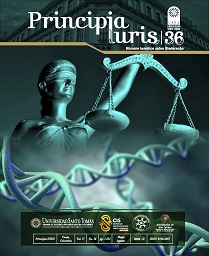Biolaw in the twenty-first century
Main Article Content
Abstract
Article Details
Por medio de esta comunicación certifico que el artículo que estoy presentando para posible publicación en la revista institucional impulsada de la Facultad de Derecho de la Universidad Santo Tomás seccional Tunja, Principia Iuris, es de mi entera autoría, siendo sus contenidos producto de mi directa contribución intelectual.
Todos los datos y referencias a publicaciones hechas están debidamente identificados con su respectiva nota bibliográfica y en las citas que se destacan como tal.
Por todo lo anterior, declaro que el material presentado se encuentra conforme a la legislación aplicable en materia de propiedad intelectual, y por lo tanto, me hago responsable de cualquier reclamación relacionada a esta.
En caso de que el artículo presentado sea publicado, manifiesto que cedo plenamente a la Universidad Santo Tomás seccional Tunja los derechos de reproducción del mismo y accedo a las modificaciones que de forma se requieran para adaptarse a la estética de la revista. Como contraprestación de la presente cesión, declaro mi conformidad de recibir (2) ejemplares del número de la revista en que aparezca mi artículo.
References
Baron, J. (2006) . Against Bioethics. Cambridge: MIT Press.
Binet, J.R. (2012). La réforme de la loi bioéthique: commentaire et analyse de la loi n. 2011-814 du 7 juillet 2011 relative a la bioethique, Paris: Lexis Nexis.
Cook, M. (2015). Disdain for bioethics ignites controversy, BioEdge http://www.bioedge.org/bioethics/disdain-for-bioethics-ignites controversy/11516. Accesed 9 August 2015.
Cyranoski, D. (2015). Chinese scientists to pioneer first human CRISPR trial. Gene-editing technique to treat lung cancer is due to be tested in people in August, Nature News Online. http:// www.nature.com/ news/chinese-scientists-to-pioneer-first-human-crispr-trial-1.20302 . Accesed 21 July 2016.
Craven, L. et al. (2016). Research into Policy: A Brief History of Mitochondrial Donation. Stem Cells, 34(2), 265-267.
Cyranoski, D. & Reardon, S. (2015). Chinese scientists genetically modify human embryos. Protein and Cell. Nature News Online. https:// www.nature.com/news/ chinese-scientists-genetically-modify-human embryos-1.17378. Accesed 12 July 2016.
Dworkin, R.B. (1996). Limits. Toe Role of the Law in Bioethical Decision Making, Medicine, Health Care and Philosophy, 1(2), 180-181.
Garattini, S., Bertelé , V & Bertolini, G. (2013). A failed attempt at collaboration, BMJ, 347, l.
Goold, I. & Herring, J. (2014). Great Debated in Medical Law and Ethics, Palgrave: Basingstoke.
Fineschi, V, Neri, M. & Turrillazzi, E. (2005). Toe new Italian law on assisted reproduction technology (Law 40/2004). J Med Ethics, 31, 536- 539. Italian National Bioethics Committee, Neuroscience and pharmacological cognitive enhancement: bioethical aspects. http:// presidenza.governo.it/bioetica/eng/opinions.html. Accesed 25 July 2016.
Jasanoff, S. (2016). Toe Ethics of Invention: Technology and the Human Future. New York: WW. Norton & Company.
Katz, J. (1985). Can Principles Survive in Situations of Critical Care? In, J.C. Moskop & L. Kopelman (Eds.), Ethics and Critical Care Medicine (pp. 41-67). Dordrecht: D. Reidel Publ. Comp.
Ledford, H. (2015). CRISPR, the disruptor. Nature, 522, 20-24. Lewis, S.L. & Maslin, M.A. (2015). Geological evidence for the Anthropocene. Science, 17(349), 246-224.
McLean, S.A.M. (2015) . Mitochondrial DNA Transfer. Sorne Reflections from the United Kingdom . BioLaw Journal, 2, 81-88.
Monastersky, R. (2015). Anthropocene: Toe Human Age. Nature, 519, 144-147. National Institute on Aging of the US Department of Health and Human Services. https://www.nia.nih.gov/research/publ ication/global health-and -aging/living-longer. Accesed 25 July 2016.

